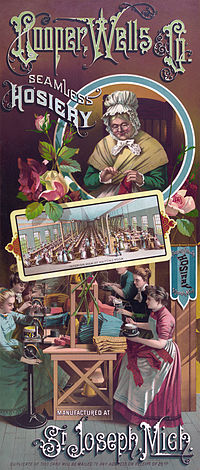A knitting machine is a device used to create knitted fabrics in a semi or fully automated fashion.
There are numerous types of knitting machines, ranging from simple spool or board templates with no moving parts to highly complex mechanisms controlled by electronics. All, however, produce various types of knitted fabrics, usually either flat or tubular, and of varying degrees of complexity. Pattern stitches can be selected by hand manipulation of the needles, or with push-buttons and dials, mechanical punch cards, or electronic pattern reading devices and computers.
Types
Advertisement for a late 19th-century hosiery firm that depicts its
factory floor with workers using knitting machines. Published 1886.
To produce larger and more complex knitted items, such as garments, domestic and industrial machines, with either flat or circular beds, producing rectangular or tubular fabrics, respectively, are needed. Double bed machines have two flat beds facing each other, in order to produce purl and plain rib fabrics plus a variety of multi patterns. Ribbing attachments can be added to single bed machines to achieve a similar result.[1]
Late 20th century domestic/studio models typically use up to 200 latch-hook needles to hold the stitches in fine, standard, mid-gauge or bulky gauge needle. A carriage or cam box is passed across the bed of needles causing the needle movements required to produce each next stitch. By means of various selection methods, e.g. punch cards, particular needles can be caused to travel by alternate pathways through the cam box. Thus needles will knit or not, and the unknitted yarn portions will lie under (slip stitch) or over the needle or be held in the needle hook (tuck stitch). Needles can be placed in holding position to allow short row shaping.[2] In the most modern machines, punchcards have been replaced by computer control.
Modern Electronic Knitting Machines
Domestic knitting machines use the weft knitting method which produces a fabric similar to hand knitting. Knitting proceeds more quickly than in hand knitting, where (usually two) straight needles are held in the hand and each stitch is manipulated individually across the row. Knitting machines work an entire row of loops in a single movement.
-
A hobbyist spool knitting machine operates on a crank.
Comparison to hand knitting
The fabric produced using a knitting machine is of a more even texture than hand-knitted fabric, which is particularly noticeable on large areas of plain stockinette stitch, and can be an advantage. Some stitch patterns (e.g., tuck stitches) are much easier to produce with a knitting machine. Others (e.g. garter stitch) can also be produced with machine knitting but can take a little longer but still much faster than hand knitting. The standard gauge 200-needle machine can knit the finest yarns up to a good sport-weight, while the heavier yarns knit better on a mid-gauge or bulky knitting machine.Machine knitting saves a considerable amount of time but does require learning to operate the machines correctly. Most if not all hand knitting patterns can be worked up on a machine, either identically or in a similar design. Hand knitting patterns are designed to "flip" the fabric on every row so that the knitter consistently uses the dominant hand. However, machine knitting is consistently knit with the fabric facing the same way. Flat Bed machines knit back and forth and Circular machines knit continuously in the round.
















